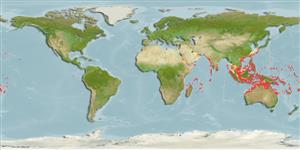Classification / Names
Common names from other countries
Main reference
Size / Weight / Age
Max length : 65.0 cm TL male/unsexed; (Ref. 11441)
Length at first maturity
Lm ?, range 30 - ? cm
Environment
Marine; reef-associated; non-migratory; depth range 5 - 80 m (Ref. 89707), usually 5 - 50 m (Ref. 37816)
Climate / Range
Tropical, preferred ?; 32°N - 24°S, 32°E - 171°W (Ref. 5222)
Distribution
Indo-Pacific: Red Sea south to Mozambique and east to the Phoenix Islands, north to Japan, south to Australia. Probably including all the islands of the tropical Indian Ocean.
Countries | FAO areas | Ecosystems | Occurrences | Introductions
Short description
Dorsal
spines
(total): 11;
Dorsal
soft rays
(total): 14-16;
Anal
spines: 3;
Anal
soft rays: 8 - 9. Juveniles with alternating blue and red stripes and 1or 2 black spots at caudal base (Ref. 4319); adults with greenish to brownish grey color with reddish spots overall; 3-4 pale stripes on side of variable intensity; body elongate, greatest depth 3.1-3.7 in SL; rounded caudal fin; short pelvic fins, not reaching anus (Ref. 90102); head pointed, 2.3-2.5 times in SL; interorbital region narrow, dorsal head profile almost straight; preorbital narrow, depth 14-17 times in HL; snout distinctly longer than eye; rounded preopercle, finely serrate, lower serrae only slightly enlarged, lower edge fleshy; ventral edge of interopercle with a shallow indentation: opercular spines small, upper edge of operculum distinctly convex; maxilla reaches past eye, exposed part covered with tiny cycloid scales; rear end of maxilla without bony process; well developed supramaxilla; palatines without teeth; canines at front of jaws rudimentary or absent (Ref. 89707).
IUCN Red List Status (Ref. 115185)
Threat to humans
Harmless
Human uses
Fisheries: minor commercial; gamefish: yes
More information
ReferencesAquacultureAquaculture profileStrainsGeneticsAllele frequenciesHeritabilityDiseasesProcessingMass conversion
Tools
Special reports
Download XML
Internet sources
Estimates of some properties based on models
Phylogenetic diversity index
PD50 = 1.0000 many relatives (e.g. carps) 0.5 - 2.0 few relatives (e.g. lungfishes)
Trophic Level
3.9 ±0.62 se; Based on food items.
Resilience
Low, minimum population doubling time 4.5 - 14 years (Preliminary K or Fecundity.)
Vulnerability
Moderate to high vulnerability (52 of 100)
Price category
